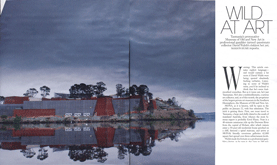W Magazine | January 2011
WILD AT ART
Tasmania’s provocative Museum of Old and New Art is professional gambler-turned-passionate collector David Walsh’s riskiest bet yet. Marion Hume reports.
Warning: this article contains explicit language-and would contain a lot more if David Walsh were being quoted absolutely fucking verbatim. Listening to some of Walsh’s rants, you’d be inclined to think he’s some foulmouthed comedian. But as it turns out, he’s just Tasmanian. He’s also a multimillionaire, a serious art collector, and, as of this month, the proprietor of the largest private art museum in the southern hemisphere, the Museum of Old and New Art.
MONA, as it is known, will be open to the public on January 22, with free admission. The trick is getting there. First, one must travel to Tasmania, a large and chilly island to the south of mainland Australia, from whence the most famous export is probably Errol Flynn. Next is a 40-minute catamaran ride up the Derwent River from the capital of Hobart, after which visitors enter a 50-year-old modernist house perched on a cliff, descend a spiral staircase, and arrive at MONA’s literally cavernous galleries: 62,000 square feet spread over three subterranean levels.
Walsh made his fortune as a professional gambler-being, as he puts it, the “1-in-200 million who can beat the odds.” During the past 30 years, he has developed a high-tech probability-crunching system that he uses to bet on horse races. How it works exactly, Walsh won’t reveal. In fact, he won’t even admit to being rich: “Some people think a couple hundred million dollars is not a lot of money,” he says.
Some of Walsh’s winnings are invested in a boutique winery called Moorilla; he also owns a beer-brewing enterprise, Moo Brew, and a destination restaurant, The Source, situated on the same peninsula as the museum. For the past two decades, however, his primary passion has been art. He’s amassed a highly individual collection on which he has lavished some $100 million (although how much anyone else would have paid to own Belgian conceptual artist Wim Delvoye’s excrement-producing installation, Cloaca, is open to debate). As the name of his museum suggests, Walsh’s tastes run from the ancient (Roman Empire mosaics and Egyptian sarcopagi) to the cutting-edge (Jenny Saville’s monumental paintings of female flesh and Stephen J Shanabrook’s sculptures of suicide bombers rendered in chocolate). And despite saying he does not have the body for it, Walsh also posed nude for Andreas “Piss Christ” Serrano.
The recurring themes of MONA’s collection are sex (the most overt example being Greg Taylor’s 141 life-size porcelain figures of female genitalia) and death. New Zealand artist Julia deVille has been commissioned to create a vessel for funereal ashes, making it possible for art lovers to remain at MONA for all eternity. And Walsh has purchased the right to film 66-year-old Christian Boltanski in his studio 24 hours a day for the rest of his life. Images will be transmitted to MONA. The longer the Frenchman lives, the more the piece will cost. Walsh, an atheist, wants to encourage exploration of “secular death”. “Why does death have to be seen as a religious event?” he asks. “Whenever I hear the phrase ‘It’s just part of life,’ I want to puke.'”
A few feet from MONA’s cliff-top entrance is a cube about three stories high, which Walsh was forced to build to house an Anselm Kiefer installation. “I had no choice, otherwise he wouldn’t sell it to me,” says Walsh. “What annoys me is that if he were a lesser-known artist, I would have been able to push him around, but because he’s big….” A contrarian to the extreme, he hates having to acknowledge he is part of the art system he despises. “Artists are arseholes, art dealers are arseholes, art collectors are arseholes, because human beings are arseholes,” he says, adding, “very few people buy art to look at it. It’s all about making a statement about yourself.” Even the work in his own collection is not immune from his contempt. Among his holdings is Jake and Dinos Chapman’s sculpture Great Deeds Against the Dead, yet he says of the British brothers; “Anyone who thinks their art is great is a fuckwit. They’re fuckwits who don’t understand they are the victims of their joke and that’s what makes it interesting.”
Walsh’s intent in opening a private museum is not philanthropic-as you might have guessed. “Philanthropy is doing what people want done for them,” he says. “While some might find MONA stupid, offensive, or a nice way to spend a Sunday afternoon, it’s not going to change lives like bowls of rice.” And while contemporary art fans will no doubt be drawn by Walsh’s blue chip holdings-he owns Basquiat’s Skin Flint, a Damien Hirst spin painting, and Chris Ofili’s Holy Virgin Mary (best known as the painting over which Rudolph Giuliani sued the Brooklyn Museum of Art in 1999), cultural education is not his goal, either. His sole aim, he says, is enjoyment. “When kids go to Disneyland, they are not trying to judge the quality of their experience,” he says. “I’m trying to create a sense of wonder so that visitors can allow themselves to have fun rather than trying to be smart.”
To defray some of the museum’s costs, there’s the likelihood of increased sales at Walsh’s
nearby winery, brewery and restaurant. And above ground next to MONA are eight art-filled glass-and-metal accommodations in which visitors willing to spend $950 a night can sleep-or not. “We expect people to do a fair bit of shagging,” says Walsh, who hopes guests will be inspired by the collection’s strong sexual content. “Really, art is about human engagement,” opines Walsh. “It’s about going back to being young, trying to get laid.”



